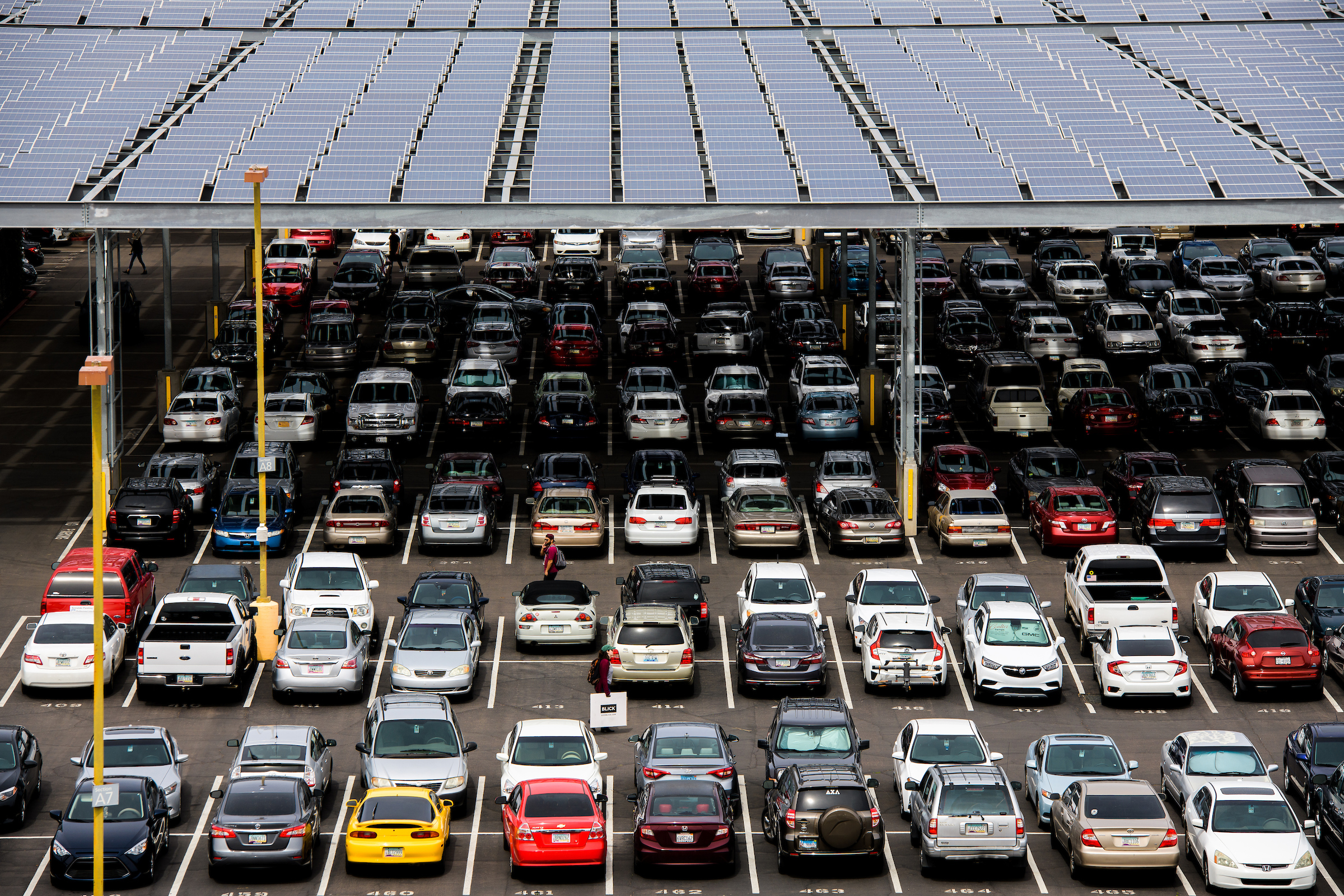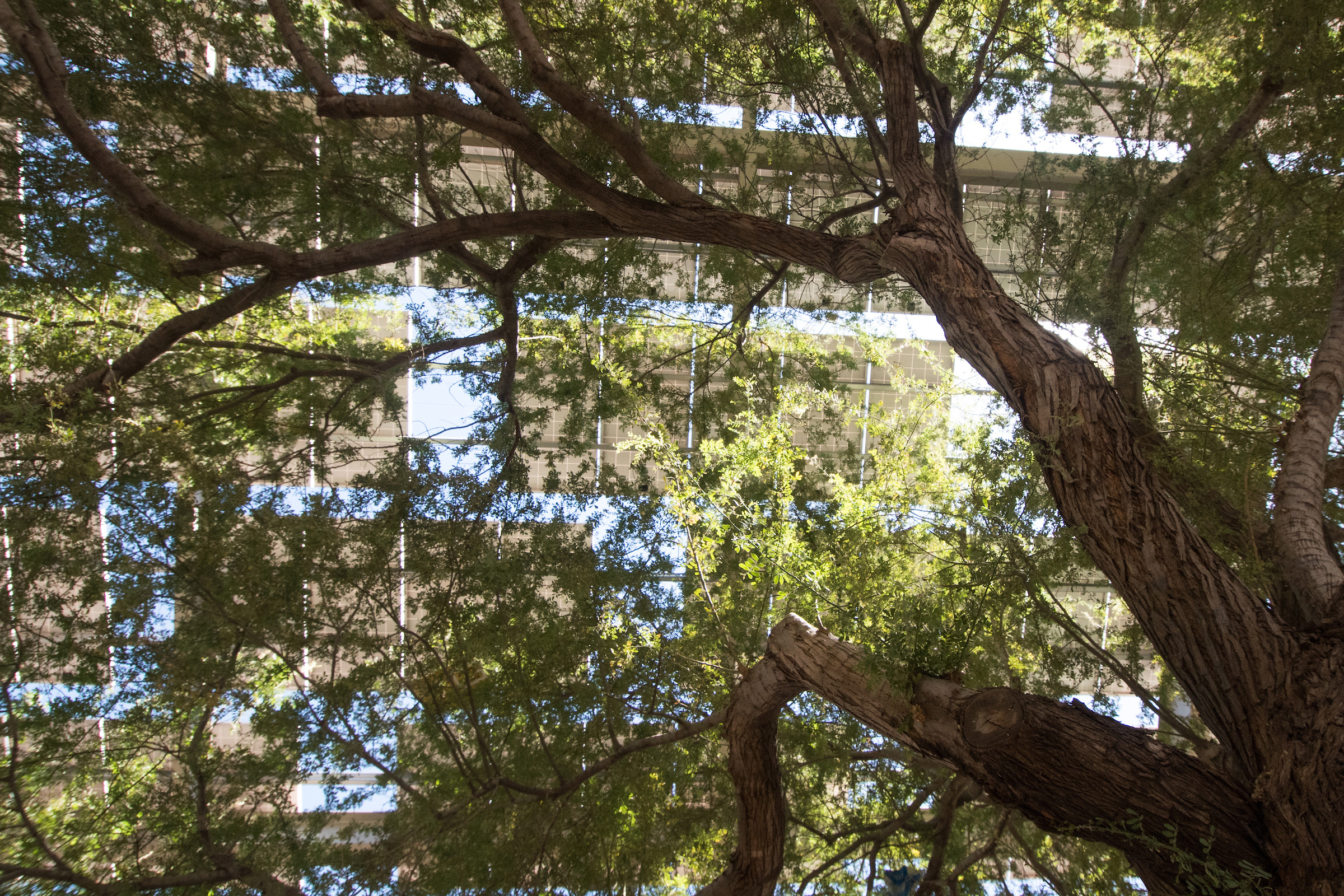Autumn means looking forward to the first crisp evenings and breaking out the cozy layers — elsewhere in the country, that is. In Phoenix, residents still have weeks or months of warm weather ahead, and that’s after a summer of record-setting temperatures.
Not only is Phoenix situated in the Southwest desert — the hottest region in the United States — it also happens to be the hottest major city in the country, and among the hottest in the world. More than 300 days of sun and thousands of square miles of concrete, asphalt and glass combine to make Greater Phoenix a living laboratory for the urban heat phenomenon and its associated ills.
And it’s only getting hotter.
Climate scientists predict daytime high temperatures will get higher, and nighttime low temperatures will continue their alarming upward trajectory. This is happening in a city that has already warmed an average of 5 degrees Fahrenheit over the past century, according to Nancy Selover, the state’s climatologist at ASU’s Arizona State Climate Office.
This geographic and climatic sweet spot places Arizona State University in a unique position to study the complex dynamics of the urban climate system. Its teams of researchers are exploring ways to mitigate extreme heat and develop strategies to improve the quality of life — not only locally, but with ideas that can have a positive impact on a global scale.
Addressing the issue from multiple angles
What makes this an even more pressing issue is the knowledge that extreme urban heat is an induced problem and, on a macro level, it’s being exacerbated by climate change that is making the Southwest warmer.
“There are such extreme conditions here that if we can make a difference, then presumably, the lessons learned are applicable to other places. Phoenix is a perfect laboratory,” said Wellington “Duke” Reiter, senior adviser to the president at ASU.
“We live in a First World nation with available resources. We have the means by which to address this problem — others may be less fortunate. I think we have an obligation to give it a shot.”
And that’s exactly what’s happening.
Across multiple disciplines, bringing together climate and social scientists with planners and designers, ASU is developing and evaluating strategies for sustainable urban designs and living.
The epicenter of this work is happening at the university’s Urban Climate Research Center.
Studying the effects of landscape change and its impact on urban heat has personal meaning for Matei Georgescu, associate professor in ASU's School of Geographical Sciences and Urban Planning and a senior sustainability scientist at ASU’s Julie Ann Wrigley Global Institute of Sustainability.
In 2002, Georgescu joined his parents on a cross-country trip to Arizona, where they settled in northwest Glendale. At the time, the house was at the edge of the urban expanse.
A year later, when Georgescu visited on winter break, he could no longer see the desert landscapes that had once been visible from the home.
“The buildup had been happening so rapidly that there was a complete replacement of the natural land,” he said.
This instilled a lifelong interest in the phenomenon of urban heat and became the subject of his dissertation, which developed land-use models to quantify the effects on climate, energy and water.
“I fell in love with the subject because it was something I could see, something I could feel and it had meaning for me personally,” Georgescu said.
Lot 59 — infamous among students in years past for its sun-baked expanse — has become more hospitable thanks to the addition of extensive solar shade panels. Photo by Jarod Opperman
Georgescu recently put the university in the spotlight for his work as part of a research team that published a groundbreaking analysis quantifying the projected value of urban farming on a global scale. The benchmark study, “A Global Geospatial Ecosystem Services Estimate of Urban Agriculture,” was published in the journal Earth’s Future and was covered in a variety of news media outlets. One scientist notably called the study “a major advance.”
The study found that not only does urban agriculture have the potential to increase global food production by several percent, but it has other tremendous benefits such as reducing the use of fossil fuels, generating an energy savings of up to 15 billion kilowatts and cooling the built environment.
Georgescu is now leading a similar analysis for the Phoenix metropolitan area.
“This is a complex system where you need architects, urban planners, climate scientists, multiscale analyses, transportation engineers — that’s what’s going to get the job done,” Georgescu said. “And that is the real strength of ASU, which is bringing all these components together.”
As a climatologist and assistant professor in the School of Geographical Sciences and Urban Planning, David Hondula studies the impacts of extreme weather on health and society. He is engaged in research that can help governments better understand extreme heat and develop strategies in how to respond to it.
“Hurricanes, tornadoes, floods and storms attract a lot of attention, but extreme heat and cold are actually the leading causes of weather-related deaths,” he said. And in Maricopa County, there are more than 100 heat-related deaths each year.
What makes extreme heat such a hazard? “The persistent, chronic nature of it,” Hondula said. “Heat is a discriminating hazard. It picks on elderly, poor and people who don’t have the means to get out of harm’s way.”
Helping the city prepare
Hondula is working with the city of Phoenix to develop a first-of-its-kind readiness plan that will guide how the city identifies, tracks, prepares for and responds to the dangers of extreme urban heat. The “HeatReady” program would be a comprehensive approach to heat management, much like other cities have done for catastrophic storms.
Recently, the “HeatReady” idea was selected as a finalist in the Bloomberg Philanthropies’ Mayors Challenge, a national competition that challenges cities to confront their most pressing problems and to develop innovative ideas to solve them.
Phoenix advanced as one of 35 finalists out of a pool of more than 320 applications and will earn a $100,000 grant to further develop the program. Ultimately, it could receive a $1 million or $5 million grant.
Hondula is also working on a National Science Foundation-funded project to study and model the impacts of a large-scale power failure that would occur simultaneously with an extreme heat event in Phoenix, Detroit and Atlanta. He said they have already identified cooling centers in Arizona that are backed up by generators, and those that are not.
Many of these projects have a heavy education component for undergraduate and graduate students, who have been gaining experience in the field and in the labs.
One of the most physically noticeable effects of urban heat is a rise in nighttime temperature during summer. In other words, the cooling effect in the city is not happening like it once did.
For example, if Phoenix doesn’t get lower than, say, 90 degrees at night, then the next morning when the sun comes up, the day naturally starts warmer.
“There is a cumulative effect. It will ratchet up over a number of days, and that’s what happens with those heat waves that we experience,” Selover said. “I like to refer to it as the nights aren’t long enough anymore.”
She attributes this, in part, to dense building materials such as concrete and pavement, which hold heat much longer than natural materials and don’t dissipate it well.
“When you have more natural materials and those that are not so dense — dirt and sand — they don’t conduct the heat very deeply into the material, so when the night comes, the heat is very near the surface and it dissipates very quickly,” Selover said.
“Within a half-hour, a natural surface will be cool. Anytime you can move yourself into less dense materials you will have less heat storage.”
ASU’s campuses have hundreds of types of trees (find a map of Tempe notable trees at bit.ly/2KR7hl5), and they beautify the campus while providing much-needed shade. But shade doesn’t have to mean trees — relief from the sun can also be found with covered walkways, artistic shade structures and solar canopies that generate power while shading people and cars. Photo by Ellen O'Brien
Another debilitating factor of extreme heat is a person’s direct exposure to radiation. Any Phoenician can attest that the thermal difference under a shade tree vs. direct sunlight is immediate and dramatic.
This is one of the reasons Phoenix adopted its Tree and Shade Master Plan, which has the ambitious goal of achieving 25 percent citywide tree canopy by 2030. Currently, ASU estimates the city only maintains about 10 percent canopy coverage.
Researchers at ASU set out to quantify the gap. Increasing a neighborhood’s tree canopy from 10 percent to 25 percent would lead to a temperature reduction of 4.3 degrees Fahrenheit, while a totally bare neighborhood could see a drop of 7.9 degrees.
In the future, what we know for sure is that Phoenix’s population will continue to grow. Maricopa County, in fact, is the fastest-growing county in the United States, which will contribute to the expansion of the urban footprint and extreme urban heat.
So trees and shade alone will not solve the city’s extreme heat. What will move the needle, however, is a holistic approach to urban planning, said Nalini Chhetri, clinical associate professor and assistant director at ASU’s School for the Future of Innovation in Society, who was a principal investigator of Phoenix’s tree canopy study.
“How do we create these new buildings in the future that create shade and are able to mitigate heat in a better way? How do we create better transportation systems? How do we create oases in the cities?” Chhetri said. “A lot of work is being done in these areas so I’m quite optimistic, to tell you the truth.
“At the university, we are creating future policymakers, and we imbibe and transfer and communicate to them all of these interwoven, complex problems and I am sure that we will come up with some solutions — and we already are.”
Written by Bill Bertolino. This story originally appeared in the fall issue of ASU Thrive magazine. Top photo of downtown Phoenix by Andy DeLisle.
More Environment and sustainability

'Earth Day Amplified' promotes power of collective action
Everybody loves the concept of sustainability. They want to do their part, and the chance to say they’ve contributed to the well-being our of planet.But what does that actually mean?Arizona State…

Rethinking Water West conference explores sustainable solutions
How do you secure a future with clean, affordable water for fast-growing populations in places that are contending with unending drought, rising heat and a lot of outdated water supply infrastructure…
Meet the young students who designed an ocean-cleaning robot
A classroom in the middle of the Sonoran Desert might be the last place you’d expect to find ocean research — but that’s exactly what’s happening at Harvest Preparatory Academy in Yuma, Arizona.…




